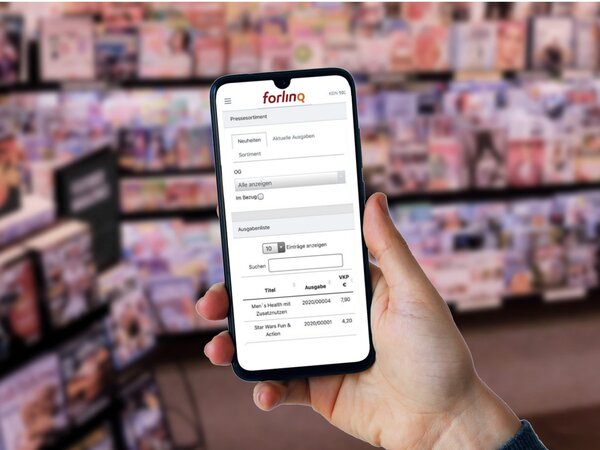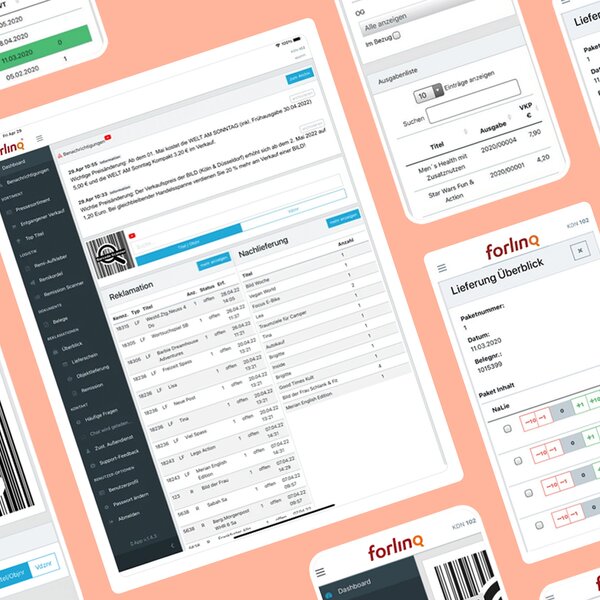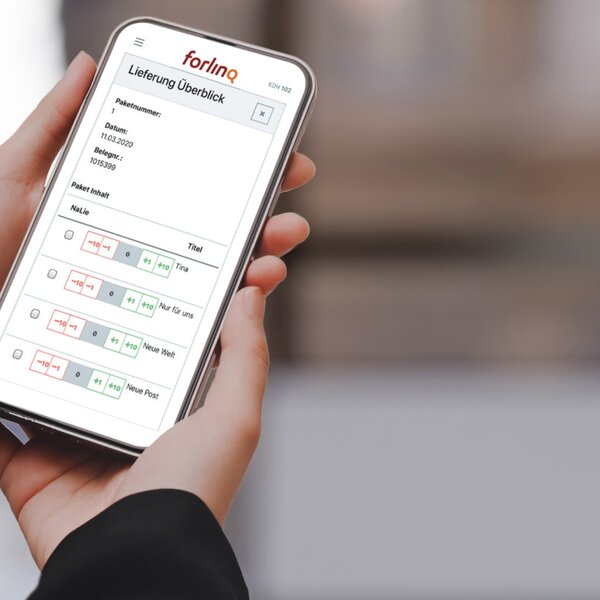Qtrado | forlinQ App
Process optimization in retail
The digitization of printing ink

-
Customer since2018
-
LocationLeverkusen
-
IndustryMedia Wholesaler
-
ServiceMobile App / Web App | Design, UX & UI | E-commerce
The agile customer app forlinQ achieves significant efficiency gains in press wholesale.
To reduce costs and increase efficiency in the press wholesale business, optimised processes were established based on the forlinQ app developed for this purpose. After a classically managed pilot project, the company switched to agile project management in order to better fulfil customer wishes in the further development of the mobile app. The result is successful software that customers are happy to use.

Innovative processes for a traditional industry
How do newspapers and magazines get to the kiosk, railway station or supermarket shelf? Early risers are familiar with the shrink-wrapped stacks of magazines that are delivered to retailers; they contain individually counted copies of the latest issues as well as repeat orders of popular magazines; unsold old copies are returned to the publisher at the same time.
This nightly service is handled by local press wholesalers. Intensive communication is required to manage the complex processes behind this - previously by telephone, later by fax, then also by e-mail. To make this process more efficient, press wholesalers have ushered in a new era with the introduction of digital tools. To this end, Krankikom developed the mobile app forlinQ, which has been enthusiastically received by retailers.
A centralised mobile app for efficient communication
The development of the mobile app to digitalise the interface between the Leverkusen-based wholesaler Qtrado and its affiliated retailers began back in 2018. In view of declining print runs, the main objective was to reduce distribution costs per item, but improving processes in terms of reliability and reducing errors through digitalisation was also on the agenda. An innovative concept was developed in close cooperation between Qtrado as the client and Krankikom as the consultant and later the realiser.
The first, one-year phase of the project ended with the go-live of a minimum viable product (MVP) from forlinQ, which was designed from the outset as the basis for further development steps. This MVP covered returns processing, including the interfaces to the client's existing ERP software and the customisation of the processes there. After the launch of the MVP, the project was systematically developed further. In addition to the original function of the app, various other processes were digitalised over time. The circle of customers also expanded. Various wholesalers with a total of over 25,000 points of sale now use the system.

Agile approach as a success factor
While the first project phase was managed conventionally on the basis of a specification sheet, further development was based on agile project management methods. This was a key factor in the success of forlinQ, as it generated a high level of satisfaction with the result among all those involved - and in a target group whose members are generally not 'digital natives'. The app initially offers them greater transparency, allowing the retailer to track whether their order has been correctly recorded and is being processed - an important factor, not least emotionally.
An objective economic success criterion was a significant reduction in calls to the wholesalers' call centres. This not only saves time and effort, but also improves the retailer's processes, because while employees are on the phone or stuck in a queue, they are not available to their customers.
The basis for this success was a high level of user participation. The wholesalers are involved via an advisory board, which has the opportunity to make its own requirements. Using a contact option built into the app, retailers have now submitted over 1,000 suggestions for improvements, many of which have already been implemented.
The backlog permanently comprises around 100 change requests, which are regularly discussed with the client, prioritised and then implemented in order of importance.
New requests and ideas are constantly being added, through which the product is constantly being expanded, improved and made more user-friendly - it has now reached four times the size of the original MVP.
Additional wholesalers have also been added to the backend systems. Right at the start of the project, the client defined the ERP system interface as an independent database - firstly to avoid overloading its backend systems and secondly to save its few developers, some of whom are not very experienced with these technologies, from having to implement APIs. In this way, a universal interface was created that minimises the effort required to adapt to other ERP systems.
The forlinQ app currently includes the following functions:
-
Real-time informationReal-time information on all delivery processes
-
Information on publicationsInformation on publications such as front pages, prices or available advertising material
-
Past transactionsCall up past transactions such as purchases, sales and return deliveries
-
Barcode scannerCall up all articles using a scanner and the barcode printed on the publication
-
Availability checkReorders in the event of exceptional sales quantities; information can be called up immediately as to whether the item is available from the wholesaler so that the retailer can give the customer a reliable promise.
-
Inventory maintenanceSupport in maintaining magazine shelves: sales staff can scan the magazine and receive immediate feedback as to whether the product is still current or should be returned.
-
Complaints and reorderingAt the point of sale, deviating delivery quantities can be identified and claimed immediately and reorders can be placed without delay.
-
Campaigns and advertising materialInformation about campaigns and ordering advertising material
App development enables economic optimization
The success story of forlinQ was only made possible by the rapid amortization of the project - with the help of the agilely developed app, savings were achieved that exceeded the development costs in every single year.
The close cooperation with our client, whose project managers have a high level of expertise and a good understanding of both development projects and in-house processes, was crucial to this. Close cooperation at the working level was also important, where new ideas were validated and modified to such an extent that they could be implemented.
Finally, it was also the focus on the needs of the users, the retailers, that led to the high level of acceptance at the points of sale. This gave retailers the opportunity to prioritize the functions according to their wishes; for example, return delivery support will be more important for retailers without specialist staff than for specialist retailers.
The decisive success factor was the agility of the project. No one could have written a specification at the beginning that would have even come close to today's solution. Many of the original ideas were discarded because they turned out to be unfeasible, because they were superseded by better ideas or because other issues became more important. The prerequisites for this approach were the client's willingness to engage with such a way of working, coupled with a high level of personal expertise, and the mutual trust between the client and service provider that had developed during the pilot project.